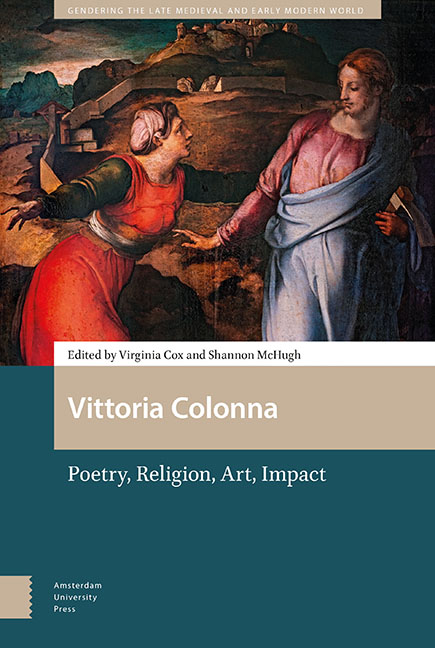Book contents
- Frontmatter
- Dedication
- Contents
- List of Illustrations
- Acknowledgements
- Introduction: The Twenty-First Century Vittoria Colonna
- Part 1 Literary and Spiritual Sociability
- Part 2 Widowhood
- Part 3 Poetry
- Part 4 Art
- Part 5 Readership
- Part 6 Impact
- Volume Bibliography
- Index of Citations of Colonna’s Letters and Verse
- Thematic Index
9 - Titian, Colonna, and the Gender of Pictorial Devotion 199
Published online by Cambridge University Press: 16 December 2021
- Frontmatter
- Dedication
- Contents
- List of Illustrations
- Acknowledgements
- Introduction: The Twenty-First Century Vittoria Colonna
- Part 1 Literary and Spiritual Sociability
- Part 2 Widowhood
- Part 3 Poetry
- Part 4 Art
- Part 5 Readership
- Part 6 Impact
- Volume Bibliography
- Index of Citations of Colonna’s Letters and Verse
- Thematic Index
Summary
Abstract
Titian made a painting of Mary Magdalene for Vittoria Colonna, perhaps identifiable with a painting in the Pitti Palace. Despite considerable scholarly attention over the last thirty years, scholars have not reached a consensus about most aspects of this exchange. Central to the debate has been the question of nudity: was it possible to have a devotional image that so knowingly exhibits female flesh? Can a painting gleefully subvert the rules of decorum and still discharge its function as a devotional image? Recent scholarship on the visual culture of female spirituality at this time helps illuminate how the picture operated within contemporary devotional culture, as does attention to Colonna's own religious verse.
Keywords: Titian, Michelangelo, Vittoria Colonna, Mary Magdalene, female devotion, patronage, religious poetry, pornography
What does a devotional picture look like? This question may seem straightforward, but an ever-increasing body of art historical research into early modern devotion makes clear that it is only deceptively so. This essay seeks to illuminate the challenges of discussing early modern devotional images by focusing on the figure of Vittoria Colonna and her relationship to Titian. Around 1531 Titian produced a painting of the Penitent Magdalene for Vittoria Colonna (Fig. 9.1), which has often been identified as the painting now in the Galleria Palatina at Palazzo Pitti. Whether or not this specific painting made its way to Colonna is complicated, but it is clear that if this is not Colonna's painting, Titian produced for her a painting quite like it. Such acts of self-citation or copying were common in Titian's workshop at the time; thus, we shall concentrate our analysis on the Pitti painting on the assumption that it closely resembles the picture for Colonna. In focusing on the Pitti Magdalene I hope to accomplish three things. First, I want to clarify a few important points regarding the relationship between Titian and Colonna. Recently, scholars have gravitated toward understanding Colonna as a patron in the exchange with Titian. However, reading the documentary record against other commissions that Titian undertook in the 1530s shows that this is not a simple case of art patronage. Second, I want to examine our understanding of what devotional pictures looked like in the middle of the sixteenth century. Numerous scholars have taken issue with Titian's painting for Vittoria Colonna, suggesting that it is little more than thinly veiled pornography. I resist this secularizing assessment of Titian's painting.
- Type
- Chapter
- Information
- Vittoria ColonnaPoetry, Religion, Art, Impact, pp. 199 - 228Publisher: Amsterdam University PressPrint publication year: 2021



